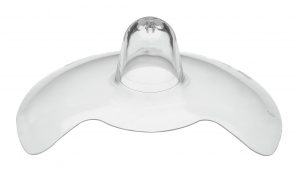 Nipple shields are little silicone devices that can be placed over a mother’s nipple and areola while she breastfeeds her baby.
Nipple shields are little silicone devices that can be placed over a mother’s nipple and areola while she breastfeeds her baby.
And this is what the HSE’s National Infant Feeding Policy has to say about their use:
“7.9.2 Nipple shields should not be recommended, unless there is a clinical reason for their use and this reason should be discussed with the mother and documented. Any mother considering the use of a nipple shield must have the potential risks explained to her prior to commencing use. She should remain under the care of a skilled practitioner whilst using the shield and should be helped to discontinue its use as soon as possible. Mothers using a nipple shield prior to her milk coming in should be assisted to stimulate her milk supply by expressing. The infant’s intake must be closely monitored.”
Which is all fine. Makes perfect sense. Nipple shields should not be handed out like jellies to every mother who is struggling with breastfeeding. They should only be recommended in situations where their use is appropriate, or where there is a “clinical reason” for using them.
However, the above policy on nipple shield use seems to have been interpreted by many to mean “nipple shields should not be used, ever. They are bad. They are detrimental to breastfeeding and maintaining a full milk supply. Tell mothers they CAN NOT USE these things.” This is certainly the impression I’m getting lately, based on what I’m hearing from clients in my private practice. I had one client who wanted to use nipple shields while still in hospital (her baby had an anterior tongue tie which was making breastfeeding very painful) and was told by a senior staff member that she would have to use them “at her own risk.” Another client with particularly flat nipples spent two weeks in hospital with her baby (due to some complications) and during that time she pumped and bottlefed him expressed milk. Several staff members tried to help her get the baby latched and feeding at the breast, but without any success. At no point was the use of a nipple shield suggested. I saw this mum when her baby was 3 weeks old. We used a shield and baby latched and fed without any fuss, and several months later this client is still feeding her baby at the breast using shields. I had another client who used nipple shields to help transition her preterm baby from bottles to feeding at the breast – with success. However, when she was back in the hospital for a routine check-up she was told by a staff member that she would need to stop using the shields asap.
It may sound like I am being critical of hospital staff, but my issue is not with them. Not at all! What bothers me is the lack of clarity around the use of nipple shields and apparent confusion about the “clinical reasons” for their use. Just when CAN they be recommended? At the moment you could be forgiven for thinking that there is a blanket policy in our maternity hospitals on not using them at all. Which really doesn’t make sense, because sometimes the humble little nipple shield can mean the difference between a baby feeding at the breast and not feeding at the breast.
Some of the situations where nipple shields can be used successfully include
- where a baby has difficulty latching due to flat or inverted nipples
- a preterm or late preterm baby who needs a little extra intraoral stimulation to trigger a sucking reflex
- a baby who has a weak or disorganised suck (eg following a traumatic delivery)
- a mother who wants to transition baby from bottlefeeding to feeding at the breast
- where baby has a tongue tie and cannot get a deep latch (shields are not appropriate for all tongue tied babies)
- some circumstance where baby has a congenital condition such as cleft palate or Pierre-Robin syndrome)
And they really only should be used under the guidance of a lactation consultant. For most mothers they are a short term fix. What I hear over and again from mothers who had been using shields, is that at some point in their breastfeeding relationship (often around the 6 week mark), baby decides they don’t need the shield any more and they do just fine feeding without them. Sometimes it’s simply a matter of time and growth, and increased nipple stretchiness that makes the transition to feeding without the shields possible.
For more info on nipple shields see:
http://www.emmapickettbreastfeedingsupport.com/twitter-and-blog/in-defence-of-nipple-shields
Caoimhe I agree with everything you say! Isn’t it wonderful to see a baby feed at the breast and the the relief in a frustrated mother when it all starts to work. So many give up which is a shame when a tiny piece of silicon could save the day !
Hear hear! I wish my client today had been given the option 6 weeks ago. 6 weeks of pumping and a baby who doesn’t not want to latch even with a shield. Nothing is black and white….